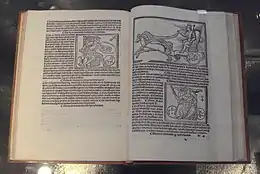Abu Mashar Sindhi
Abu Ma'shar Al-Sindi, (Latin) Abulmazar (Arabic) ابو ماشرالسندي (d.170 A.H.) : was a scholar of Hadith literature (8th century Hijra) from Mansura, Sindh now the part of Pakistan.
Abu Ma'shar Al-Sindi ابو ماشرالسندي | |
|---|---|
 Translation into Latin of a work of Albumasar De Magnis Coniunctionibus ("Of the great conjunctions"), Venice, 1515. | |
| Personal | |
| Born | |
| Died | 170 AH Baghdad, Abbasid Caliphate |
| Religion | Islam |
| Ethnicity | Sindhi |
| Era | Islamic Golden Age |
| Region | Abbasid Caliphate |
| Creed | Sunni |
| Main interest(s) | Hadith, Seerah, Fiqh |
| Occupation | Scholar of Islam |
| Muslim leader | |
Influenced
| |
| Part of a series on |
| Sunni Islam |
|---|
 |
|
|
Life and work
Arab rule produced men of note in Sindh, and some of them achieved fame and distinction in Damascus and Baghdad. One of them was Abu Mashar Sindhi. He was described by some historians and chroniclers as a pioneer in the compilation of Hadith.
Abu Mashar Sindhi was Muslim world's noted scholar of Seerah and Fiqh. He lived at Medina for a number of years and later shifted to Baghdad where he died. He was a very respected figure and in fact, the Abbasid Caliph Al-Mahdi led his funeral prayers.
His son Abu Abdul Malik Sindhi was also an eminent scholar and historian of South Asia who had settled down in Baghdad. Another of his relatives was the young Hafiz Abu Mohamniad Khalaf bin Salem Sindhi who was a Hadith scholar and had migrated from Sindh to Iraq where he attained fame.
References
- The new encyclopedia of Islam
- Arab kingdom of al-Mansurah in Sind - Page 145
- Influence of Islam on Hindi literature - Page 8
- The Voice of Islam - Page 96
- History of India and Pakistan, Volume 2 - Page 34
- The contribution of Indo-Pakistan to Arabic literature, from ancient times ... - Page 12
- History of Muslim civilization in India and Pakistan: a political and ... - Page 49
- Education in Sind: past and present - Page 73
- Islamic and comparative law quarterly - Page 115
- Islamic culture: the Hyderabad quarterly review - Page 21
